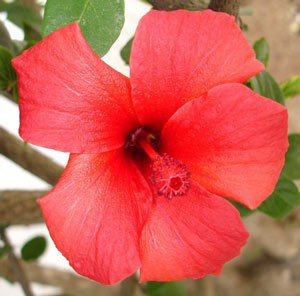
I have a hibiscus tree that I brought in this past summer and the leaves are curling in. What is going on?
Thanks.
I have no idea. I do know that several insects use webbing to draw the leaves around their nest. Do closely examine the curled leaves, both topside and bottom.
Both of these plants hibiscus grew beautiful flowers, but now seem to have some disease both on leaves and stem. Their location was changed to another part of the house, then they were brought to the original location, which has more sunlight and where they bloomed many a time, this happened.
Is there a way to treat them?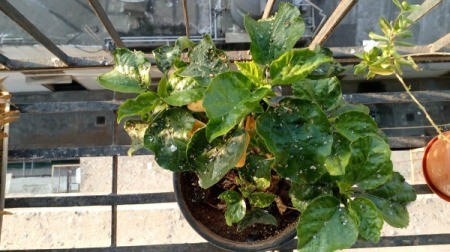
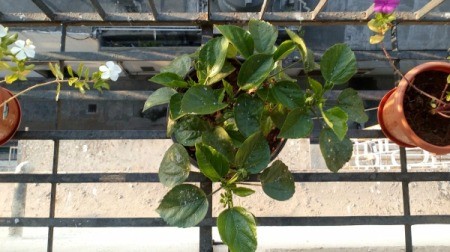
I just planted a variegated hibiscus and overnight something shredded/ate virtually every leaf. I live in Queensland, Australia. Could the culprit be a brush turkey?

I had lots of aphids on my hibiscus. I sprayed soapy water on it after the sun went down, but since I live in Florida, the next day there was plenty of sun. Within a few days all the leaves and buds fell off. Did I kill it or will my hibiscus come back?
By Linda from Sebastian, FL
At least 50 years ago a brother in law told me that I could determine whether a plant was still alive by scratching it on the main "trunk". If it's still green the plant is still alive. I'm sure your hibiscus is still alive. I certainly hope so! I love those things!
I have an potted hibiscus that is almost 5 feet tall and blooms continuously all winter. In the summer I put it outside in a partly sunny location and it remains healthy, but does not flower.
What am I doing wrong?Last year was the first time I tried hardy hibiscus. I got roots from a mail order catalog and planted them in late spring with plenty of sun. We have very sandy soil so I water often, every 2 days, saturating the soil. The leaves on all 3 plants are cupped to such an extreme that the new leaves look like miniature lobster claws. The older leaves look like little boats. They haven't lost any leaves, they are still growing and there is no yellowing.
The biggest plant hasn't bloomed at all. The second biggest plant had 2 blooms, the smallest had 3 buds; 2 small buds that dried up and fell off. The 3rd bud did bloom. Both flowers had beautiful color (white with a burgundy center), but they didn't open up the way they should. They weren't as big as the ones I've seen on plants not 4 hours from here. There were spaces between the petals. The petals were sort of long and slender.I also have Black-Eyed Susan at the end of this same bed with some leaves misshapen and having bronze like spots on tops and under sides of leaves, as well as a fringe of bronze around the edges. These flowers are small, but otherwise look normal. They aren't a year old yet, so maybe small blooms are normal?
Has my bed got some sort of disease? Or are they starving for nutrients? I've fed them liquid iron 2X in the last month, added organic granules to the soil when they first came up in spring and drenched them with a 20-20-20 soluble food 1 or 2 times in the last 2 weeks, thinking it might help. I don't want to give them too much food for fear of causing more problems. These are the only plants effected in that bed, the sedum and Red-Hot Pokers are fine. Anyone?
By LorindaWalshCO from Walsh, CO
Never mind. Day after day I have searched the web for an answer, and asked everyone I talked to if they might know what is wrong with my poor pathetic flowers. No answers could I find. Then last night I figured it out! And all by my desperate self. Both the hibiscus and the Black-Eyed Susans have powdery mildew. It appears that the disfigured leaves and spots are the prelude to the white stuff; which has now made its grand entrance.
It's really sad because, I was so excited and so proud of myself for figuring out the problem on my own, because ten minutes later both of my Black-Eyed Susans (blooms and all!) were sheared to ground! The Hibisbus will suffer the same here in a few hours. Then the treatment & recovery begin.
I didn't get to read your article before you sheared your babies down, but both will return. The powdery mildew I keep at bay by making sure my hibiscus is in a lot of sun and in the rainy season, I use dawn dish soap and bleach (doesn't take a lot) in a quart sprayer about a tsp.
I have many hibiscus plans and several seem stressed. What can I do to help them?

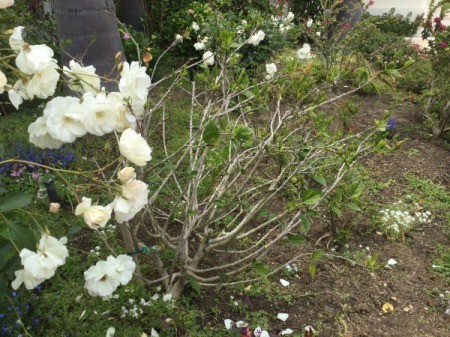
Last year I was having trouble with the leaves on my hibiscus cupping very badly. Also with a Black-eyed Susan, the leaves weren't cupped, but deformed and scarred. I came to the conclusion that they had powdery mildew; all symptoms seemed to point in that direction.
This year they both came up looking perfectly fine and healthy. They were growing as they should. Then they started to look a little tattered as time passed. Of course I gave them a good shot of soapy water and fed them. I staked the hibiscus for support against the wind. They just slowly started looking worse.
I think I was incorrect in my diagnosis of powdery mildew last year. We get a lot of wind here for several days in a row at times (20 to 30 mph gusts and 15 to 20 sustained). There is nothing on this side of the house for a wind break. I placed some bricks, with 3 holes in them, a little way in front of the flower beds that were the worst target for the wind. In just 1 week the Black-eyed Susan was showing a great deal of improvement. Now it is sporting several buds. The hibiscus plants however are more toward the back of the bed and are too tall for these small bricks to make a much of a deflection against the wind. The hibiscus looks just as they did last year, there is very pronounced cupping of the leaves (most especially the newer leaves).
I am going to move them to a new location where maybe they'll be somewhat protected from the harsh winds. It is, however, in a partly shaded area. Can plants actually get mildew in an area where there is rarely any humidity or rain? We live in zone 5 in the very southeast corner of Colorado, the very southwest corner of Kansas, and just north of the Oklahoma panhandle.
We are now in the process of planting as many lilac bushes as we can around the property for a windbreak. I planted an assortment of 9 shrubs last year for this very purpose. Not nearly enough to cover the area we need covered in the country. I don't have the time to wait for those 9 shrubs to grow into a windbreak. They were planted in well thought out places, with the intent to fill in the gaps by adding a few new shrubs every year. But it is what it is and I have 6 very mature lilac bushes that have oodles of shoots just begging to be dug up. I just transplanted 10 in a line on the problem side of the property and we're not halfway through digging holes yet! I hope that deflecting the wind improves the growing conditions on that side if the house. So many ideas, but nothing seems to grow well there.
So, I guess the question is, what kind of wind can a hibiscus tolerate and what would the damage to the plant entail? I could be wrong again about the wind, too. The plants leaves are cupped and they just look altogether fatigued.
By LorindaWalshCO from Walsh, CO
I wasn't able to load a picture of my poor hibiscus plants when I sent my question .... I am going to try now & hope it works.
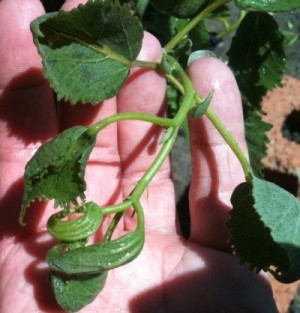
This is as far as it would open. Previous years' blooms were beautiful.
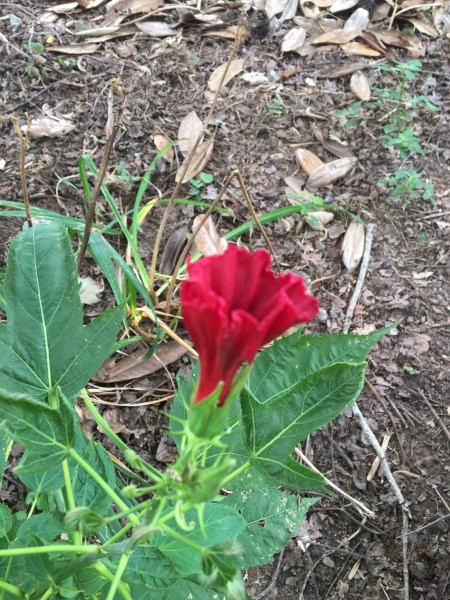
The problem could be insects, especially thrips which feed off the flower. This causes the buds to fall off before blooming. Thrips also lay eggs in the flower, causing them to turn yellow. Use an organic insecticide once a week.